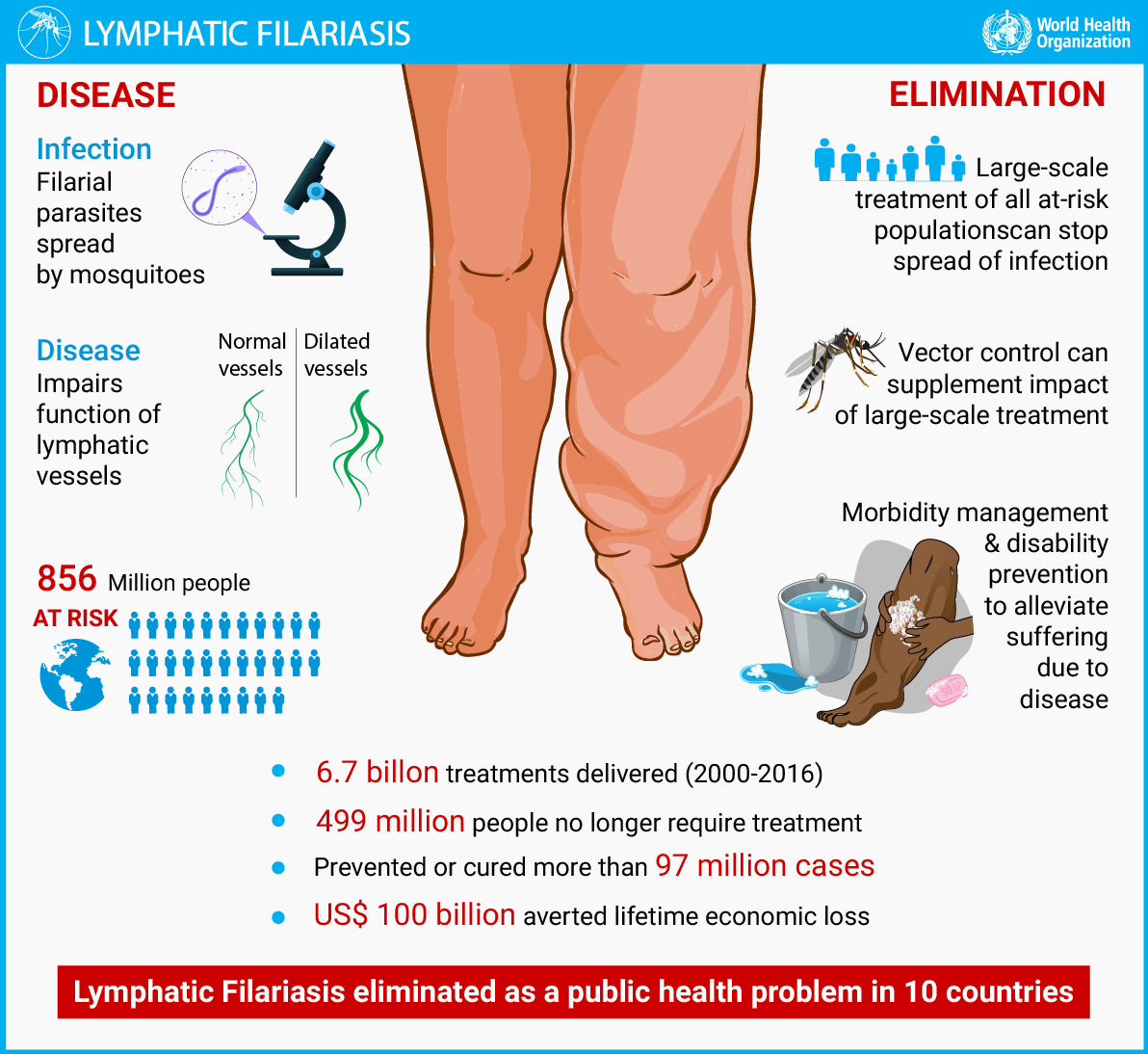Important Facts For Prelims
Lymphatic Filariasis
- 14 Feb 2024
- 5 min read
Why in News?
Recently, the Union Minister of State for Health and Family Welfare launched the first phase of the Bi-annual Nationwide Mass Drug Administration (MDA) campaign for Lymphatic filariasis (LF) elimination.
Note:
- The campaign aims to check disease transmission by providing free preventive medications to the residents in areas affected by the disease. The campaign will cover 92 districts across 11 states.
What is Lymphatic Filariasis?
- About:
- Lymphatic filariasis, commonly known as elephantiasis, is a neglected tropical disease(NTD) caused by infection with filarial parasites transmitted through mosquitoes.
- Prevalence:
- In 2021, approximately 882.5 million people in 44 countries lived in areas requiring preventive chemotherapy to halt the spread of infection.
- LF is a serious public health problem in India. Currently, there are 345 lymphatic filariasis endemic districts in 20 states and union territories of the country.
- 75% of MDA districts are from 5 states Bihar, Jharkhand, UP, Odisha and Telangana.
- Lymphatic filariasis is more prevalent among the urban poor and affects all segments of the rural population.
- Impact:
- The infection starts in childhood and accumulates through adulthood, resulting in irreversible chronic disease conditions.
- The disease inflicts stigma, mental suffering, social deprivation and economic loss and is a major cause of poverty in the affected communities.
- The infection starts in childhood and accumulates through adulthood, resulting in irreversible chronic disease conditions.
- Cause and Transmission:
- Parasitic Infection:
- Lymphatic filariasis is caused by infection with parasites classified as nematodes (roundworms) of the family Filariodidea. There are 3 types of these thread-like filarial worms:
- Wuchereria bancrofti (responsible for 90% of the cases)
- Brugia malayi (causes most of the remainder of the cases)
- Brugia timori (which also causes the disease)
- Lymphatic filariasis is caused by infection with parasites classified as nematodes (roundworms) of the family Filariodidea. There are 3 types of these thread-like filarial worms:
- Transmission Cycle:
- Adult worms reside in the lymphatic vessels, producing microfilariae that circulate in the blood.
- Mosquitoes become infected by biting an infected host and transmit the larvae to humans, perpetuating the transmission cycle.
- Parasitic Infection:
- Symptoms and Complications:
- Asymptomatic and Chronic Conditions:
- The majority of infections are asymptomatic, but chronic conditions can lead to lymphoedema (swelling of the limbs), elephantiasis (thickening of the skin and tissues), and hydrocele (swelling of the scrotum), causing physical disfigurement and psychological distress.
- Acute Episodes:
- Acute inflammatory episodes often accompany chronic conditions, leading to debilitating symptoms and loss of productivity among affected individuals.
- Asymptomatic and Chronic Conditions:
- Treatment and Prevention:
- Preventive Chemotherapy:
- MDA with annual doses of medicines to the at-risk population is the World Health Organization (WHO) recommended strategy for eliminating lymphatic filariasis.
- MDA Regimens:
- Different drug regimens are recommended based on co-endemicity with other filarial diseases, aiming to reduce microfilariae density and interrupt transmission.
- Morbidity Management:
- Surgery, hygiene measures, and clinical care are essential for managing chronic manifestations and preventing disease progression.
- Vector Control:
- Supplemental strategies such as mosquito control help reduce transmission and complement preventive chemotherapy efforts.
- Preventive Chemotherapy:
- WHO Response and Goals:
- Global Programme to Eliminate Lymphatic Filariasis (GPELF):
- Launched in 2000, GPELF aims to eliminate lymphatic filariasis as a public health problem through preventive chemotherapy and morbidity management.
- In 2020, GPELF set the following goals for the new NTD Road Map (2021–2030):
- Validation: 80% of endemic countries (58) to validate elimination, maintaining low infection rates post-MDA.
- Surveillance: All endemic countries (72) to implement surveillance to prevent disease resurgence.
- MDA Reduction: Targeting zero population needing mass drug administration.
- Global Programme to Eliminate Lymphatic Filariasis (GPELF):
- India's Initiatives:
- Mission Mode India Multi-drug administration (MDA) Campaign twice a year synchronized with National Deworming Day (10th Feb and 10th August)
- India is committed to eliminating Lymphatic Filariasis by 2027, three years before the global target.







